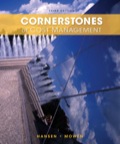
Concept explainers
1.
Construct a cost report for C Company showing the value-added, non-value cost and total cost of each activity
1.
Explanation of Solution
Value-added cost: A value added cost is the cost incurred by the business to perform the value added activities in order to achieve optimum efficiency in their operations. Value-added costs are calculated using the following formula.
Non-value added cost: A non-value added cost is the cost incurred by a business on non-value added activities that adds to the total cost of the business but does not contribute to the required efficiency. Non-value-added costs are calculated using the following formula.
Prepare a cost report of C Company showing the value-added, non-value added and total cost of each activity of C Company.
| Cost report of C Company | |||
| For the year ended 2014 | |||
| Activity |
Value-Added cost ($) |
Non-value Added cost ($) |
Total Cost ($) |
| Receiving | 252,000 (1) | 126,000(3) | 378,000(7) |
| Assembly | 1,125,000(2) | 225,000(4) | 1,350,000(8) |
| Expediting | 0 | 300,000(5) | 300,000(9) |
| Storing | 0 | 84,000(6) | 84,000(10) |
| Total | 1,377,000 | 735,000 | 2,112,000 |
Table (1)
Working notes:
(1) Compute the value-added cost of receiving activity of C Company.
(2) Compute the value-added cost of assembly activity of C Company.
(3) Compute the non-value-added cost of receiving activity of C Company.
(4) Compute the non-value-added cost of assembling activity of C Company.
(5) Compute the non-value-added cost of expediting activity of C Company.
(6) Compute the non-value-added cost of expediting activity of C Company.
(7) Compute the total cost of receiving activity of C Company.
(8) Compute the total cost of assembling activity of C Company.
(9) Compute the total cost of expediting activity of C Company.
(10) Compute the total cost of storing activity of C Company.
2.
Give reasons for the activity of expediting products and storing goods being catagorized as non-value added activities.
2.
Explanation of Solution
Both expediting aand storing activities are actually unnecessary activities that consume resource without influencing any change of state.
3.
Explain the implications for reducing the cost of waste for reach activity assuming receiving cost is a step-fixed cost with each step being 1,500 orders and assembly cost is a variable cost.
3.
Explanation of Solution
For receiving activities, cost reduction can only be made when the actual demand for receiving orders is reduced by each block of 1,500 orders. In the case of assembly activities, each hour that is saved produce a saving of $15. As a result, reduction in spending can benefit better for assembly activity than for receiving activity.
Want to see more full solutions like this?
Chapter 12 Solutions
EBK CORNERSTONES OF COST MANAGEMENT
- Calculate return on assets (ROA) accountingarrow_forwardCan you solve this financial accounting problem using appropriate financial principles?arrow_forwardSuntech Corporation disposed of equipment at the end of the fourth year of its estimated life for $28,000 cash. The equipment's life was originally estimated to be 7 years. The original cost was $95,000, with an estimated residual value of $11,000. The equipment was being depreciated using the straight-line method. What was the gain or loss on the disposal? Solve thisarrow_forward
- Suntech Corporation disposed of equipment at the end of the fourth year of its estimated life for $28,000 cash. The equipment's life was originally estimated to be 7 years. The original cost was $95,000, with an estimated residual value of $11,000. The equipment was being depreciated using the straight-line method. What was the gain or loss on the disposal?arrow_forwardPlease provide the solution to this general accounting question with accurate financial calculations.arrow_forwardCleopatra Production Inc. estimated its manufacturing overhead costs for 2024 to be $360,000, based on 120,000 estimated machine hours. The actual machine hours for 2024 were 110,000. The manufacturing overhead account contains debit entries totaling $352,000. Determine whether the manufacturing overhead for 2024 was overallocated or underallocated.arrow_forward
- Please explain the solution to this financial accounting problem using the correct financial principles.arrow_forwardI am looking for help with this general accounting question using proper accounting standards.arrow_forwardPlease provide the answer to this financial accounting question using the right approach.arrow_forward
 Cornerstones of Cost Management (Cornerstones Ser...AccountingISBN:9781305970663Author:Don R. Hansen, Maryanne M. MowenPublisher:Cengage LearningPrinciples of Accounting Volume 2AccountingISBN:9781947172609Author:OpenStaxPublisher:OpenStax College
Cornerstones of Cost Management (Cornerstones Ser...AccountingISBN:9781305970663Author:Don R. Hansen, Maryanne M. MowenPublisher:Cengage LearningPrinciples of Accounting Volume 2AccountingISBN:9781947172609Author:OpenStaxPublisher:OpenStax College Principles of Cost AccountingAccountingISBN:9781305087408Author:Edward J. Vanderbeck, Maria R. MitchellPublisher:Cengage Learning
Principles of Cost AccountingAccountingISBN:9781305087408Author:Edward J. Vanderbeck, Maria R. MitchellPublisher:Cengage Learning


